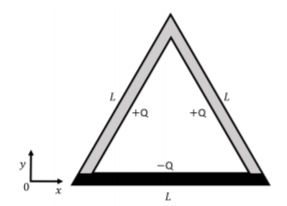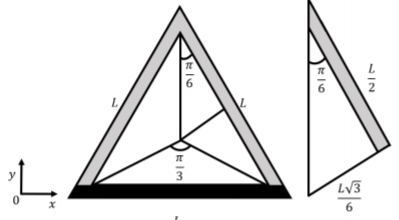16.7: Sample problems and solutions
( \newcommand{\kernel}{\mathrm{null}\,}\)
Consider three charged rods of length L which are arranged to form a triangle, as shown in Figure 16.7.1. If the charge on each rod is evenly distributed, what is the net electric field at the center of the triangle?

- Answer
-
We can model the object as the sum of three finite length wires of the length, L. In Example 16.3.3, we determined that the electric field produced by a finite wire is:
E=2kλRsinθ0
We can determine geometrically that θ0=π6, as in Figure 16.7.2. The distance, R:
R=L2sinθ0

Figure 16.7.2 Thus, the field from one wire is given by:
E=2kλRsin(π6)E=kλR
Given that the charge Q is evenly distributed along the rod of length L, we can rewrite the charge density as QL, which gives:
E=kQRL=kQL√36L=6kQ√3L2
This is the magnitude of the electric field for each side of the triangle. The two positive wires will produce electric fields whose vertical components cancel. The negative wire will produce a field that points downwards. Summing together the electric field vectors:
∑→E=6kQ√3L2(cos(π6)−cos(π6))ˆx+6kQ√3L2(−1−2sin(π6))ˆy∑→E=−12kQ√3L2ˆy
Which is the final answer.
Suppose a dipole is in an electric field →E. Show that the dipole will experience simple harmonic motion if the angle between the dipole vector and the electric field vector is small.
- Answer
-
The only net torque on the dipole is from the force from the electric field:
τ=−pEsinθ
where we have inserted a minus sign to indicate that this is a restoring torque, in the opposite direction of increasing angle θ. The net torque is equal to the moment of inertia times the angular acceleration:
−pEsinθ=Iα∴α=−pEIsinθ∼−pEIθ
where in the last equality, we made the small angle approximation (sinθ∼θ). This has the form for simple harmonic motion:
d2θdt2=−ω2θω=√pEI

